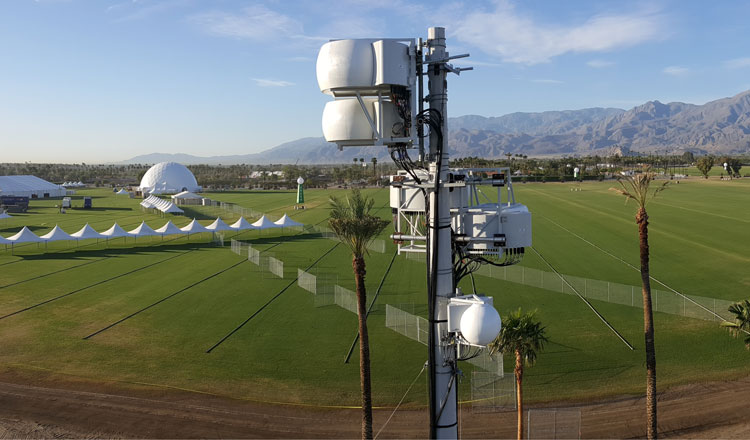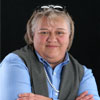
If you blink, you may miss it.
In an instant, thousands of people across the country turn vacant fields and open deserts into booming cities. For 2-weeks, festival-goers live and breathe the music of their favorite artists, surrounded by new friends, eclectic art, and photo-worthy moments. As the bands play, fans—mostly data-hungry, social-savvy millennials—are snapping photos and videos, and instantly sharing their experiences.
They expect their photos and videos to post immediately. And my team works hard so that they do.
Here’s how we set up temporary, high capacity wireless networks to support music festivals – from the urban core of Chicago, to a desert in Indio.
Where we come in.
Every summer, Manchester, Tennessee experiences a population boom from approximately 10,000 to over 80,000 smartphone-wielding festival-goers. This overnight growth can strain an unprepared network and leave data-hungry fans with spinning wheels on their devices. In 2009, we made it a priority to improve the customer experience at large-scale events. Whether in populous cities or small towns, we’re boosting our network for about 140 events each year, including many big-name music festivals. Over the past 6 years, we have invested more than $29 million, and have deployed over 430 Cell on Wheels (COWs) and Cell on Light Trucks (COLTs) to better serve our customers at concerts and music festivals nationwide.
If you’re asking yourself—what do COWs and COLTs have to do with a network? Both COWs and COLTs are portable network facilities that we deploy to provide extra coverage and capacity when large concentrations of customers are present.
While we boost our networks for many big events, music festivals are unique.
Tens of thousands of people can transform 700 acres of farmland into a mini-metropolis overnight. With some people camping onsite during the festival, it’s not only important they stay connected to update social media, but to get help in case of an emergency.
To help keep attendees connected in these environments, we get creative with building a network to support them.
Each year, my team faces a challenge. Our goal is to build temporary networks that give attendees a similar mobile experience as they would have walking down the street of a major city. For music festivals in both rural areas and big cities, we’ve developed a network equipped with some of our highest-capacity antennas.
The moment a festival ends, my team goes to work preparing for the next year. We look at data usage, foot traffic and peak hours. We ask ourselves: where is there room to improve? The options and technology we have to enhance our network has changed drastically since we started focusing on big events in 2009. We’ve put a cell tower on wheels, introduced the Drum Set and Giant Eyeball antennas that provide 10-20x the capacity of a single beam antenna – and we’ll need to keep innovating, as demand shows no sign of slowing.
Looking to the future.
AT&T customers keep shattering our data records. At the 2017 Festival in Indio, California, we saw nearly 40 TB of data cross our network from Friday, April 14 to Sunday, April 23.1 That’s equal to more than 113 million selfies and is 37% more than last years’ festival.
To support the increased demand, we’re looking to the future. The advancements AT&T is making as part of our 5G Evolution with small cells and Project AirGig, could bring you even closer to a point of connection.
In a number of cities, our teams are installing small cells on light posts and other infrastructure in highly trafficked areas. These will provide a better wireless experience to fans headed to areas like San Francisco.
For those more remote festivals, we may eventually look to the solutions Project AirGig provides. This transformative technology could one day deliver low-cost, multi-gigabit wireless internet speeds using power lines—bringing connection virtually anywhere.
In the more near-future, attendees could see Flying COWs overhead. A Flying COW – which stands for Cell on Wings – is a cell site on a drone. It is designed to beam LTE coverage from the sky to customers on the ground during disasters or, in this case, big events. We expect it to provide coverage to a larger footprint because it can potentially fly at altitudes over 300 feet— about 500% higher than a traditional COW mast. Used in conjunction with traditional COWs, the Flying COW may allow us to extend coverage to the outlying areas of the festival grounds. The sky truly is the limit.
We know our customers will continue to use their mobile devices to share their experiences at music festivals. But we’re not worried.
We think these festivals are one of the tests of our wireless networks. We will continue to work to provide the best mobile experience for attendees for many festival seasons to come.
1 All figures include only data traffic from AT&T Mobility customers on AT&T’s venue-specific mobile network during the Coachella music festival.

Paula Doublin - Assistant Vice President Construction & Engineering